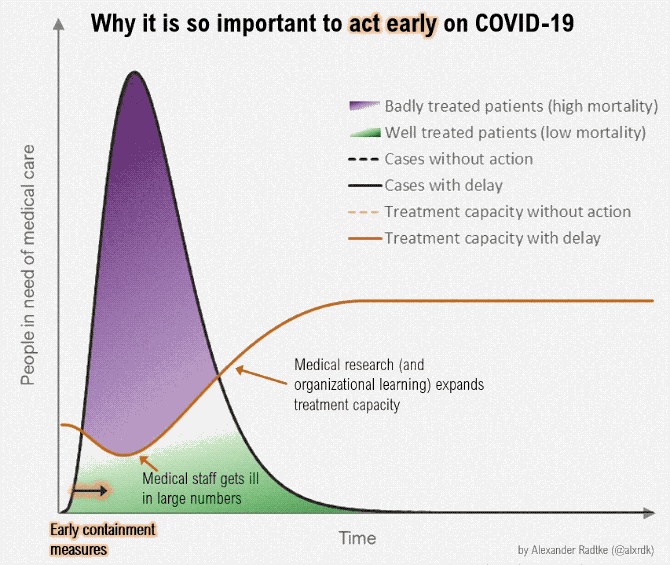
Co-published March 13th on GeriPal and Pallimed
Dear Hospice and Palliative Care community,
We are sad we cannot be together this year at the Annual Assembly and deeply concerned about the growing risk of the novel coronavirus. We want to send you a bit of encouragement, and some thoughts on how we can take care of ourselves, our teams, and our community in the setting of this new pandemic.
We have always “punched above our weight” as a field, and the secret to that has been hard work, community, and being smart.
We don’t have to tell you to work hard. You and your teams know how to do this.
1) Start social distancing from others (except patients) now, wherever you are in the country. While we realize this is a stronger recommendation than currently being asked for by many public health entities, we are doing so in the interest of health care workers and patients
–COVID-19 is spreading rapidly, sometimes with minor or no symptoms, with serious impact to healthcare systems worldwide. The exponential growth in cases in China, Italy, and South Korea has overwhelmed the healthcare systems, and has affected our patient population most seriously – the chronically ill and older adults.
–We need to be ready and able to respond when the time comes. We will be exposed to the COVID–19 virus, and we cannot afford to lose our hospice and palliative care clinicians to isolation restrictions or illness, especially given the workforce shortages many of us face already.
–Stay away from public gatherings like movies, sporting events, concerts, the theater, houses of worship and other places where people assemble. Try to participate in these from home via electronic means, if possible. Talk with your spiritual leaders about making services available via streaming tech, for example.
–Attend all meetings electronically unless physical presence is absolutely necessary. Replace non–essential meetings with email or other asynchronous communications,
–Eliminate all non–essential travel, and
–Protect yourself at work using PPE and rigorous technique. *Reminder of how to safely don and doff PPE here
2) Follow all local, state and national guidelines for COVID-19. This is critical as there are regional differences. However these hold true.
–Wash your hands or use at least 60% alcohol hand sanitizer
–Avoid touching your face. (Holly finds this impossible, so she wears her hair up and bobby pinned normally, to avoid itching her face and tucking her hair behind her ear constantly.)
–Stay home if you are sick, until the symptoms are gone for at least 24 hours. (This is hard as we have been trained to just work anyway. Don’t do it. Stay home.)
–If you are exposed and/or have COVID-19 symptoms, you should isolate at home for 14 days. If you think you should be tested, make sure you call ahead and know how your region is handling testing for health care workers. (You should have received copious emails from your institutions on this. If not, contact your institution’s occupational health team or COVID response team for local instructions on how to access testing.)
–If you have traveled to or had a layover in any of the 5 countries (China, Iran, Italy, South Korea, or Japan) then you need to stay in isolation at home even if you are asymptomatic. Note these countries may change after this is originally posted on Mar 12, 2020.
–See CDC for the latest guidelines: www.coronavirus.gov
–Wash your hands the right way. (Yeah, we said it already).
3) For hospices and home-based palliative care:
—NHPCO has an excellent resource page for that includes CDC guidance for hospices on COVID-19 infection control and prevention : https://www.nhpco.org/coronavirus
–Proactively provide education to your patients and their caregivers on how to stay safe and get food, medication, pet food, household goods, and other necessities, including companies that deliver to minimize household exposure. You may deliver the patient’s medications, but their caregivers will also need to get their medications.
–Proactively remind patients and caregivers about CDC guidelines (e.g. handwashing, greeting people, etc.), and to clean their cell phones.
–Consider having non-caregiver loved ones Facetime or Skype to “visit” rather than coming in person.
–Use virtual visits whenever possible.
–For patients who need to be seen, send only the necessary team members.
–Call ahead to screen for exposure and symptoms of the patient or caregivers to see if PPE is necessary.
–Ensure your team members have appropriate PPE in their cars, as well as disposal containers. Consider donning and doffing the PPE in attached garages or entryways to help maintain patient privacy.
–Make sure people going into homes know how to don/doff PPE and are FIT tested, if appropriate.
–Wash hands or use hand sanitizer prior to and after seeing patients.
–Wipe down all equipment and cell phones before and after each patient.
–Follow all guidelines for facilities and minimize in-person visits to only needed personnel.
–Don’t let fear prevent appropriate patient care.
4) For ambulatory palliative care:
–Proactively provide education to your patients and their caregivers on how to stay safe and get food, medication, pet food, household goods, and other necessities, including companies that deliver to minimize household exposure.
–Remind patients and caregivers about CDC guidelines (e.g. handwashing, greeting people, etc.) and to clean their cell phones.
–Consider having non-caregiver loved ones Facetime or Skype to “visit” rather than coming in person.
–Screen all patients and caregivers for symptoms or exposure when calling to remind them of their appointment.
–If URI or COVID symptoms, follow your institutional guidelines about home isolation and testing.
–Consider which patients’ needs can be met with virtual or telephone visits.
–Work with your institution to implement HIPAA approved telehealth visit capabilities if you do not have them. Understanding some telehealth visits cannot be reimbursed, talk with your colleagues and health system about what amount of service can be feasibly provided without guarantee of reimbursement.
–Consider which team members really need to be in the room, versus can call to provide information or support.
–For now, do not require that patients be seen at a certain frequency for controlled substance monitoring if it can be safely done for a particular patient, unless required by law or regulation.
–Don’t let fear prevent appropriate patient care.
5) For inpatient palliative care:
–Provide education to your patients’ caregivers on how to stay safe and get food, medication, pet food, household goods, and other necessities, including companies that deliver to minimize household exposure for when the patient is discharged.
–Remind patients and caregivers about CDC guidelines (e.g. handwashing, greeting people, etc.) and to clean their cell phones.
–Consider having loved ones call, Facetime, or Skype to “visit” rather than coming in person, if they even are allowed into the hospital.
–Consider having physicians, NPs, and PAs who are at home in isolation due to a cold, travel, or COVID exposure, be a triage/advice person for your consult service. Palliative care teams are often at capacity without an epidemic, so with COVID we may need to give recommendations to non-palliative clinicians (e.g. teleconsults or curbsides) when we can, and only see the patients who need our in-person services.
–Establish and update what a “patient who needs your service” means as a team at each site, so there is not confusion if the definition changes during a surge.
For a palliative care team covering multiple hospitals, consider asking for emergency privileges now at all the hospitals, so all clinicians can flexibly cover hospitals they don’t normally practice in.
–Make sure your institution is planning for symptom management needs, like opioids and benzodiazepines for dyspnea and anxiety.
–Be prepared to offer virtual bereavement support to families who are not allowed to be with critically ill patients.
–Support other teams in the hospital, everyone will be stressed and a kind word or offer to help may go a long way.
–Don’t let fear prevent appropriate patient care.
6) For Program Directors:
–Consider going virtual for education and fellow support.
–Have the trainees see the non-COVID cases, to minimize their exposure and conserve PPE. Attending physicians will need to see the patients, and can teach about COVID outside the room, so the trainees don’t lose out on the learning.
–Consider extra support, like virtual video check-in’s, or more frequent texts/ or calls about the fellows’ well-being, given the stress on the system.
–Make sure your fellows can get food and necessities, and have a place to go, if they are asked to isolate
And as all us hopefully do, prioritize kindness. There are reports of xenophobia behaviors, and shunning of people with COVID, and with heightened emotions we may need to remind people we ALL do better when we care for each other and treat each other equally.
Finally… together we can do this. As hospice and palliative care people, we understand the value of team. And right now we are all on each other’s team. While we may be social distancing, we have a vibrant virtual community, as well your home community. AAHPM has Connect, we can find each other at the #hapc hashtag on Twitter, or at the #hpm tweetchat. Take care of you, take care of each other.
Much love folks. Let’s be safe, and let’s be prepared.
Strong back, soft front. Deep breath. Stay grounded.
Holly Yang, Alex Smith, Christian Sinclair, Eric Widera, Paul Tatum, Drew Rosielle
Resources:
NHPCO – COVID-19 Information
CMS – CMS Actionable Guidance to Providers about COVID-19 Virus




